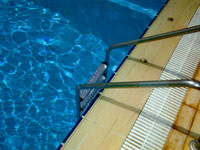Let water sit around for 24 hours — stagnating in an old tire, say, or in a birdbath in the backyard — and some pretty nasty things can start breeding in it. After Mt. St. Helen’s erupted in Washington State in 1980, newly formed oxygen-deprived pools became breeding grounds for Legionnaires’ disease. Then there’s cholera, typhoid, dysentery, and other illnesses that can be contracted from untreated bathing and drinking water. Yet, while swimming in a bacteria- and pathogen-filled pool poses clear health threats, chlorine is not a risk-free solution.

What lies beneath?
Some very harmful substances — dioxins and furans, for example, and also trihalomethanes — can form when chlorine products come in contact with carbon-containing organic matter, such as leaves and dirt. Dioxins and furans are extremely toxic and are among the “dirty dozen” chemicals targeted for elimination in the 2001 Convention on Persistent Organic Pollutants. Some studies suggest that trihalomethanes, which include the carcinogen chloroform, may cause miscarriages, birth defects, and bladder and rectal cancers.
Both chlorine and chloroform may be found in chlorinated pools and can be inhaled or absorbed through the skin. Too much chlorine in a pool also can cause skin irritation, eye irritation, and both short and longer-term respiratory problems, such as coughing, difficulty breathing, and “swimmer’s asthma.” In fact, in a study published this June in the Journal of Occupational and Environmental Medicine, Belgian researchers found that young swimmers had high levels of proteins that destroy cellular barriers in the lungs, making them more susceptible to the allergens that can cause asthma attacks. The trigger for these proteins seems to be nitrogen trichloride, a gas released during the interaction between chlorine and ammonia or ammonium compounds from urine, sweat, and other organic sources.

Not exactly good, clean fun.
More disturbing still, the researchers found that the children who swam most frequently had levels of these proteins similar to those found in regular smokers. The study concluded that regular swimming in chlorinated pools by young children resulted in an increased risk of developing asthma. The authors also suspect a link to the rising incidence of childhood asthma and allergic diseases found in industrialized nations.
But folks concerned about their health needn’t abandon swimming altogether. Here are some suggestions for healthier pool maintenance and safer swimming habits:
- Avoid chlorinator tablets. These can produce high concentrations of chlorine, which increase the risk of adverse health effects.
- Do not over-chlorinate. Test your water frequently to maintain the desired level.
- Ozonators, which dissolve ozone into pool water as a disinfectant, help reduce the concentrations of chlorine needed to keep pools sanitary, and result in fewer reports of respiratory distress among swimmers. However, an Environmental Health Perspectives article reports that ozonators do produce bromate, a possible human carcinogen.
- Consider investing in a chlorine-free pool maintenance system. While their efficacy isn’t currently guaranteed by Consumer Reports or the Consumer Product Safety Commission, ask your pool products salesperson about the many chlorine-free options available.
- Do your best to reduce the organic matter in your pool. Use covers and remove leaves and dead insects frequently.

Don’t lap up this water.
- Swim in outdoor pools, or in indoor pools with excellent ventilation. Indoor pools with poor ventilation seem to produce more adverse health effects.
- Don’t swim in highly chlorinated pools every day. If you do so, you risk building up trihalomethanes and chlorine or chlorine byproducts in your body. As these substances do not bioaccumulate, swimming intermittently gives your body a chance to cleanse itself.
- If you swim vigorously, you increase your chances of absorbing trihalomethanes and of developing respiratory problems. Children, who breathe proportionately more air for their size than adults, are also at increased risk of overexposure to chlorine and chlorine byproducts. It’s especially important for children and vigorous swimmers to exercise the above precautions.
- Reduce your overall exposure to chlorine and chlorine byproducts by keeping your drinking water in a pitcher (which allows some of the substances to evaporate) and by using filters on your drinking water tap and your showerhead. Consult The Green Guide’s product report on water filters for shopping suggestions. The National Sanitation Foundation provides certification for water-purification systems, pools, hot tubs, and spas.

